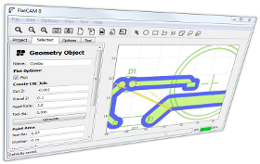
Alarm Checks: The backplot might look okay, but your program can still immediately alarm out on the machine. Extents and Soft Limits: Checks to make sure the cutter will stay within the area you want it in.ģ. Backplot: A quick visual indication of what motions the program will make with the cutter.Ģ.
#Cnc file viewer simulator
Here are 5 Ways a G-Code Simulator Can Help Test Your CNC Programs:ġ. 5 Ways G-Code Simulators Test Your CNC Programs
#Cnc file viewer how to
It doesn’t cost very much or take very long to have this peace of mind, so it’s something you should consider.īTW, when we get done going over how to use a G-Code Simulator to test your CNC programs, we’ll also talk a bit about the other ways a simulator can help you out with your CAM Software. Relying on this type of simulator is fraught with peril.īecause of that, a lot of experienced machinists insist on a separate simulated backplot as a sanity check for their g-code before they’ll run it. In other words, you aren’t really performing an independent test on the g-code. For example, bugs in the post cannot be detected this way because the post is downstream of that geometry info. This allows for subtle bugs to creep in that are not detectable in the CAM backplot. They just plot the same geometry information that was used to create the g-code output by the postprocessor. If your CAM program includes a true CNC g-code simulator, then yes, it can be used to help test g-code programs. The qualified answer is, “Probably Not.” The issue is the way CAM program simulators work.
#Cnc file viewer software
Not so fast! Doesn’t my CAM Software already have a Backplot / Simulator for this purpose?

I’m sure many of you are thinking, “Yup, I use the g-code simulator in my CAM Software all the time!” You’ll also hear the terms “Verification”, “Emulation”, and “Virtual CNC” batted around, though they’re a little less common than the other three. You need a piece of software that has variously been called a G-Code Simulator, CNC Backplot, or G-Code Viewer. It’s actually cheap and easy to run a G-Code Simulation. What if there was a better way to get a second opinion and test your gcode? One that didn’t tie up the machine and that could be done much more quickly than Cutting Air? That’s what G-Code Simulators are for. If you must Cut Air, here’s how to do it: The trouble with Cutting Air is it can be very time consuming and it ties up your expensive CNC machine the whole time.


Cutting Air is the least you should do to test (also referred to as “proving out” a part program) your gcode part program. “Cutting Air” just means running with part zero set high above the workpiece so the cutter (hopefully) doesn’t come in contact with any material until you see what it will do. Testing can range from “cutting air” to using a G-Code Simulator. You Don’t Run G-Code Without Testing It, Do You?!? ( Better not let the boss find out if you do… ) Use a G-Code Simulator to Test and Prove Your G-CodeĬonsidering what can happen if there’s a mistake in the gcode, and even CAM software makes mistakes sometimes, you want to test your gcode before you run it to make chips. 5 Ways G-Code Simulators Crush CNC Errors


 0 kommentar(er)
0 kommentar(er)
